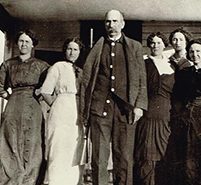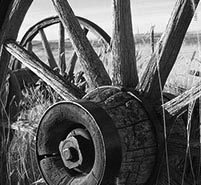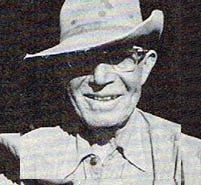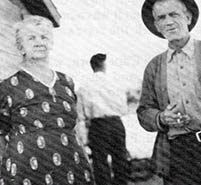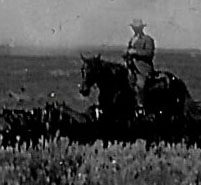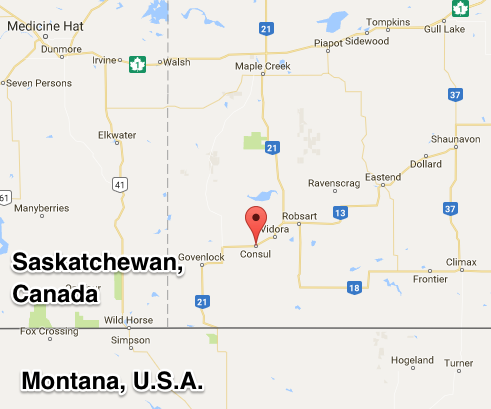W.X. Wright
Source: Heather S. Beierbach in From Sage To Timber history book
William Wright was born in 1863 in Brussels, Ontario. He had come to Western Canada and applied for a homestead (SE 16-16-5-W2nd) in 1882. This homestead was only a mile from Broadview, Saskatchewan and apparently he operated a general store there as well. It seems his next move was to California where he worked as a shipbuilding engineer. Through this time he married his wife, Lela, who had a daughter, Ruth, by a previous marriage. They were in California when the Gold Rush of the Klondike struck the north in 1896 and the Wrights were caught up in the excitement, too, and went to seek their fortune in the Yukon. No doubt their travel by ship up the west coast to Skagway was the easy part, for the challenge of the Chilkoot Pass was to await them. Once they got through that they could travel by boat again from Lake Bennett to the Klondike, but the Pass was a tremendous feat and the trial that was to be remembered and recounted by the Wrights throughout their lives.
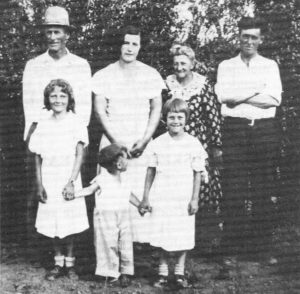 Back: Bill Lindner, Mrs. W.X. Wright, Mrs. John Lindner (Melinda), Mr. W.X. Wright. Front Row: Irene Lindner, Unknown boy, Edith Lindner Photo: From Sage to Timber
Back: Bill Lindner, Mrs. W.X. Wright, Mrs. John Lindner (Melinda), Mr. W.X. Wright. Front Row: Irene Lindner, Unknown boy, Edith Lindner Photo: From Sage to Timber
The Pass was treacherous. It was so narrow that there were places that two people could not pass. Horses and mules had been tried to pack the peoples’ supplies, but it was too narrow and steep even for them and they would slip from their precarious route to their death below. People, too, met this end if they should happen to slip or perhaps be pushed in the quest for gold. Waiting at the top of the Pass were the NWMP ready to send back anyone who did not have enough provisions to get them through the winter ahead for without sufficient food they would starve. No one could take anymore with them than they could carry on their backs and as the Wrights had the two of them to provide for they had much to carry. In all, W.X. and his wife made 40 trips up and down the Chilkoot Pass to get their supplies. Although no fortune in gold awaited W.X. he did file a claim and this is when it is said that he took the initial “X” into his name as there was another William Wright in the Yukon. As the bounty of the gold fields was not abundant his next venture was that of saloon keeper and dance master in the society which came to develop around the flurry of the gold rush.
By October of 1904 W.X. Wright and his wife had left the Yukon and had filed an application to homestead SW 24-5-30 W3rd on Middle Creek. According to the date of the homestead application and the year of his birth W.X. was 41 years old when he came to the Cypress Hills and homesteaded the Wright Place. He was known to everyone as W.X. and usually signed W.X. or William X on documents, but when he applied for his homestead patent he now signed William Xavier Wright. Had he found a name to fit the X or had he always had the name and merely coined a little tale to avoid disclosing his second name? It really does not matter, but it is fun to ponder as everyone who knew him seems to remember the story of W.X. adopting his initial X and it was a surprise to find a copy of his signature complete with a full name.
W.X. was the first forest ranger of the West Block of the Cypress Hills Forest Reserve in 1911. At the time it was questioned by various people just how effective he would be as he was never remembered riding a horse, but always drove a team and buggy wherever he went and not necessarily at a walk! Mrs. Dorothy Haigh remembers travelling with her family, the Beattys, to visit the Wrights at their place. She was a young girl of about 12 at the time, but the trip was a memorable one. Someone had come with a message for W.X. that he was needed somewhere on ranger’s business and as Mrs. Wright usually travelled with him she proceeded to get ready to go, too. She’d been making butter and baking bread and these tasks along with some quick instructions were delegated to a flustered young man who was working for W.X. Housekeeping and household tasks did not stand in the way of any excursion or a chance for visiting. So everyone was on their way, even the visiting Beattys!
One of the greatest remembrances people have of the Wrights is how they loved to visit and how they would travel far and wide to do so, paying little regard to distances or weather conditions. Mrs. Wright, especially, had a reputation for being a great visitor. Among the close friends of the Wrights were the Faulkners, Reesors, Beattys and Mrs. A.J. Smith. (Mrs. Smith’s maiden name was Hadessa McGarry. She was the sister of Jim McGarry who was one of the forest rangers to succeed W.X. She was also Mrs. Tommy Winterton’s mother).
Town for the Wrights was probably more often Walsh, Alberta than Maple Creek, Saskatchewan as the distance of either town from the Wright Place would differ little and they had such good friends with whom they could stop and visit on their trip. Their first night they would stop at Faulkners and then on to the Reesor Ranch where they would stop for another night and the last stop would be with the Beatty family of the Sarnia Ranch near Walsh, Alberta. Mrs. Beatty loved to play the piano and would hold dances in their barn loft. W.X. and Mrs. Wright would often be among the guests on these occasions and Dorothy Haigh remembers the pleasure of dancing with W.X. when she was a girl and how W.X. flattered her by telling her what a lovely dancer she was. It was a real compliment coming from a dance master. No doubt the Wrights had acquaintances at Maple Creek as well, but they also had a family connection there. Dr. Graham was Mrs. Wright’s brother. He was the doctor who delivered Graham Parsonage when he was born and in fact, Graham was so named in honor of the doctor. It is not known why, but for some reason the two families were not on friendly terms.
Ray Faulkner remembers his family coming to visit the Wrights when he was a child. He and his sister, Allie, recall how nice W.X’s house had seemed to them. It was not the present house at the Wright Place, but was a frame house with an attached kitchen to the north and on the south end was a large bay window. There were two bedrooms downstairs and two or three upstairs. W.X. had built the house with the help of a fellow called Doc Gray who was a friend or perhaps a hired hand who lived and worked with Wrights for a time.
At some point W.X. also acquired the Benson Place, now a part of the West Block of the Forest Reserve in the Cypress Hills. This was one of the spots in the Hills where many old time picnics and rodeos were held. W.X. later sold it to Frank Nuttall and the Saskatchewan government would eventually acquire it from him.
The original place where W.X. had made his home he eventually rented to various people. Some of the people who rented his place were the Omer Forester family who later settled on Merryflat, a man by the name of Draudson and Charlie Roberts and Ernie Downes who rented it in partnership. When W.X. decided to leave this country for good he sold out to the Lindner brothers in the 30s.
W.X. had run 100 head of cattle in 1905 and only 12 head of horses, but by 1912 records show him to be running 52 horses and only 25 cows. Since horses are much better at fending for themselves through tough winters than cows are and as W.X. didn’t put up any feed to speak of, the horse had become the more practical animal for him. In extra dry years when he had no grazing for his stock he had neighbors he called upon to help him out and winter his cows. Two of those good friends were William Faulkner and Frank Reesor.
After leaving the Cypress Hills W.X. and his wife settled in Washington, USA; that is where W.X. passed away.

